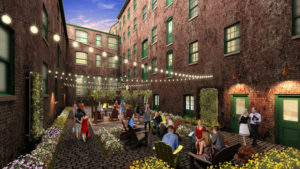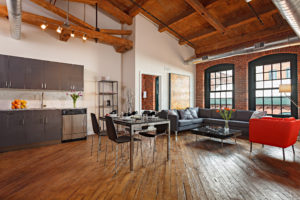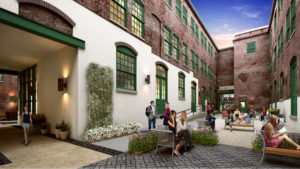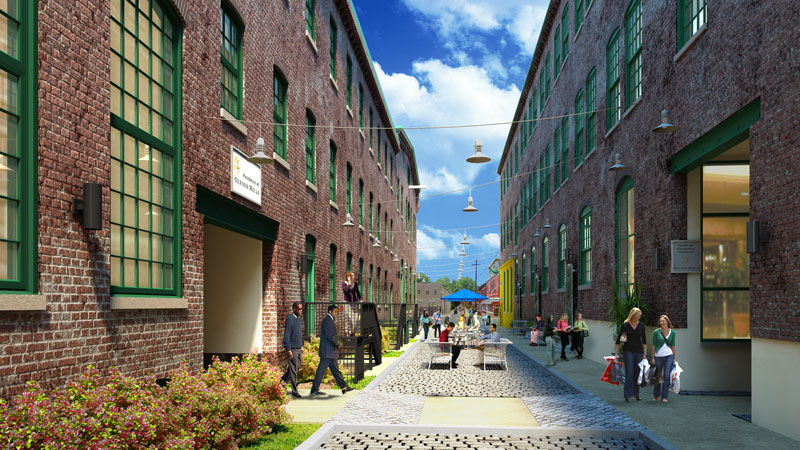It’s only fitting that Oxford Mills, one of the great textile manufacturing complexes in Philadelphia, Pennsylvania, would be reborn in a way that once again revitalizes the community.
 Erected in seven stages (between 1873 and 1913), Oxford Mills was once the largest dye works factory in the South Kensington neighborhood, and the largest recycler of surplus cotton in Philadelphia. The complex, totaling 170,000 square feet, represents a significant era in Philadelphia’s textile history.
Erected in seven stages (between 1873 and 1913), Oxford Mills was once the largest dye works factory in the South Kensington neighborhood, and the largest recycler of surplus cotton in Philadelphia. The complex, totaling 170,000 square feet, represents a significant era in Philadelphia’s textile history.
After decades of industrial productivity comprising a wide variety of uses, the buildings have undergone a historically-certified restoration using sustainable design and building methods. Transformed into elegant, affordable living and commercial space, this innovative project provides a vibrant, supportive environment where our educators and nonprofits can collaborate and thrive.
 The 25 Teach For America staff members who occupy the space seem to be unfazed by the rattle of the public transit system just a stone’s throw from their desks.
The 25 Teach For America staff members who occupy the space seem to be unfazed by the rattle of the public transit system just a stone’s throw from their desks.
As she gestures toward the bookshelves filled with resources for teachers and students, not to mention the foosball table in the corner, Sarah May, the education nonprofit’s managing director of development, says “It doesn’t feel like an office. It’s a fun place to come to work.”
Exposed-brick walls, visible ductwork, and wood-beam ceilings enclose the space, which is illuminated by light from industrial-style, metal-framed windows.
 Teach For America is just one of 12 nonprofits that have found an ideal home in this pair of former industrial buildings.
Teach For America is just one of 12 nonprofits that have found an ideal home in this pair of former industrial buildings.
Gabe Canuso and his business partner, Greg Hill, of Philadelphia-based D3 Real Estate Developers, knew they wanted to create a community that would boost the area’s public school systems. They envisioned the complex before ever laying eyes on the structures that now make up Oxford Mills.
Originally built as the headquarters of the Quaker City Dye Works between 1873 and 1913, the structures housed one of the largest employers in the larger Kensington neighborhood at the turn of the century. The firm manufactured dye, cotton and woolen yarns, and silk, gradually expanding to employ 200 workers at its peak.
More recently, starting in the 1970s, the former dye-works complex housed the Pieri Creations lamp factory. As the lamp industry moved overseas and business dwindled, however, the 175,000 square feet of space became less and less necessary. By the time Canuso and Hill scouted the property in 2011, the lamp factory had only one employee left (who they hired to maintain the restored buildings), and the evidence of years of deferred maintenance was everywhere.
“Some people might look at it and go, ‘Oh my god, this is a nightmare,’ but we looked at it as all opportunity,” Canuso says, laughing. “I mean, there were trees growing out of the roof and out of the sides. It looked like a forest in the middle of the building.”
The complex’s west building holds 94 below-market-rate apartments, designed to foster a community of education-minded tenants who would understand the unique challenges of working in a beleaguered public school system. Ideally, Canuso and Hill thought, the two buildings would create a symbiotic environment where residents and employees could support and inspire one another.
“Our goal was to bring people together and encourage people to maybe cross-pollinate from one organization to the other,” Canuso says.
 Teach For America’s vision is for students in every community in Greater Philadelphia-—especially the 60,000 living in deep poverty—-to have access to schools that honor, cultivate and promote their inherent potential. To ensure that students will be prepared for tomorrow’s challenges, schools and the communities they serve need teachers, principals and leaders who are fueled by educational equity.
Teach For America’s vision is for students in every community in Greater Philadelphia-—especially the 60,000 living in deep poverty—-to have access to schools that honor, cultivate and promote their inherent potential. To ensure that students will be prepared for tomorrow’s challenges, schools and the communities they serve need teachers, principals and leaders who are fueled by educational equity.
Teach For America’s members, teachers, and alumni work with students to achieve daily positive impact. They believe that, with a diverse perspective and approach in our programs, they will all find meaningful ways to serve, lead or partner to improve life opportunities for the city’s students.
All images courtesy of Oxford Mills.
See National Trust for Historic Preservation article by Katherine Flynn.

